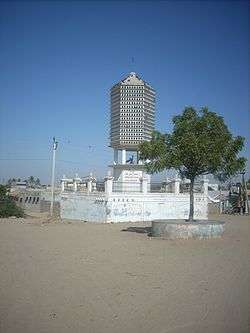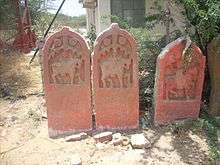Kutch Gurjar Kshatriya
Kutch Gurjar Kshatriya[1][2][3][4][5] (also known as Mistri[6][7] or Mestri[8][9]) are a minority Hindu and one of the Socially and Educationally Backward communities of Gujarat[10] in India, who claim to be Kshatriyas.[9] They are an artisan community related with Kadia works. They are also known as the Mistri or Mistris of Kutch.[7][8][11][12]
| Total population | |
|---|---|
| 51,000 | |
| Regions with significant populations | |
| India | |
| Languages | |
| Gujarati | |
| Religion | |
| Hindu | |
| Related ethnic groups | |
| Mistri, Gurjar Kshatriya Kadia, Salaat, Chunara |
History
The community is believed to be from Kota[8] and first entered into Saurashtra and founded 36 villages in the area, while others moved further into Kutch. Around 1177–78 AD (VS 1234), a major group migrated to Kutch from Saurashtra[8] under the leadership of Patel Ganga Maru.[13] They settled in the village of Dhaneti.[14][13] There are several Parias of the community, located near village pond of Dhaneti, standing as memorials of the war that was fought in 1178 AD. The community members still go once every year to offer pooja and their respects to their fore-fathers.[15]
This group, later, made their distinct identity not only by building historical forts, palaces, temples and architects not only in Kutch but also all over British India, primarily in the fields of railways and coal mining.[7]
The Kutch Gurjar Kshatriyas left Dhaneti and went on to establish eighteen villages in Kutch[8] which were granted to them by the King: Anjar, Sinugra, Khambhra, Nagalpar, Khedoi, Madhapar, Hajapar, Kukma, Galpadar, Reha, Vidi, Jambudi, Devaliya, Lovaria, Nagor, Meghpar, Chandiya and Kumbharia.[13]
Over the centuries, they have been known or identified by some other names like Kadias, Kadia Kshatriyas and Kumar Gnati.[11][13]
Culture
They are a Hindu community. Some are followers of Swaminarayan and Pranami sect of Hinduism, They are vegetarian in diet and avoid consumption of alcohol. The staple food is khichdi, vegetables, pulses and butter-milk.[9]
The community consists of clans like Rathod, Chauhan, Yadav, Chawda, Jethwa, Padhiar, Yadav, Chudasama, Parmar, Taunk, Khodiyar, Solanki, Sawaria, Vaghela, Vegad, Varu, Maru, Bhalsod, etc., who enjoy same status. However, most of people prefer to pre-fix Mistri to their name.[9]
The community are an endogamous community who practice the principle of clan exogamy. Dowry is generally not asked for, neither practice of bride price is there in community. Divorce is generally not encouraged; however, divorce can be claimed in certain cases.[9]
Betrothal ceremony generally precedes marriage, which is held usually within one year of engagement and marriage is observed as per Hindu rites by taking seven circumambulation of fire.[9]
Widow remarriage (ghargenu) is allowed, where the women is usually married outside husband's family.[13][9]
In Kutch

The Kutch Gurjar Kshatriyas were master craftsmen, architects and contractors and have played a major role in erection and construction of the majority of forts, palaces and architecture of Kutch. It was because of this they came to be known as Mistri in Kutch.[8]
Indian railways
It was during 1850 to 1930 AD that the KGK migrated outside Kutch and were involved in the construction of major rail-bridges and the laying down of railway tracks in almost all major rail routes of undivided British India doing the "Railway Thekedari" (Railway Contractors also Thikadari) and as Thekedar (or Thikadar) in Irrigation projects and Forest Department and Public Works Department.[13] They have also done major roadway, road bridges, canal works, irrigation dams and barrage work throughout British India from 1850 to 1980. The communities largest contribution is in the building of the early railway lines and bridges throughout British India. Their works in Railway construction span from 1850 to 1980 for more than one and a quarter of century.
Docks, dams and canals in British India
The KGK contributed to the building of docks, dams, barrages and irrigation canals between 1850 and 1980, and they in the eighteenth century had been among the communities who built the first ports of Bombay and Hornby Vellard. Other docks were developed in Bombay during 1870–1895 (Prince's Docks built in 1885 and Victoria Docks built in 1891[16]) in which many Mistris of Kutch and Kadia Kshatriyas of Saurashtra worked. The Mandavi Docks, bridge over Rukhmavati at Mandavi and many road bridges across territories of British India are built by the community using their mason's skills.[13]
Mining
In the regions of British India known as Bengal, Bihar and Orissa, the Kutch Gurjar Kshatriyas pioneered Indian involvement in coal mining from 1894. They broke the previous monopolies held by British and other Europeans, establishing many collieries at l Jharia coalfields and Ranigunj coalfield.[17][18]
Seth Khora Ramji of Sinugra was the first Indian to break the British monopoly in the Jharia Coalfields.[17][19] Natwarlal Devram Jethwa[17] says that
The East Indian Railway in 1894-95 extended its line from Barakar to Dhanbad via Katras and Jharia. Messrs. Khora Ramji in 1894 was working on railway lines contract of Jharia branch line and with his brother Jetha Lira was also building Jharia Railway Station, when he discovered coal in Jharia belt. The location of his three collieries named Jeenagora, Khas Jherria, Gareria is mentioned also in 1917 Gazetteers of Bengal, Assam, Bihar and Orissa.[20]
Downturn in fortunes
The majority of the once-prosperous KGK community living in Kutch and Saurashtra today are devoid of agricultural land due to land reform acts post independence of India. Presently Mistri are in the list of Socially and Educationally Backward Class community in Gujarat, however, those who are not domicile of Gujarat state cannot take advantage of this reservation.[10][11]
Present status
Distribution in India
KGK community members are found throughout India and Communities associations exist in the states of Gujarat, Maharashtra, Karnataka, Andhra Pradesh, Telangana, Karnataka, Tamil Nadu, Rajasthan, Delhi, Uttar Pradesh, Madhya Pradesh, Chhattisgarh, Jharkhand, Bihar, Orissa and West Bengal.[13]
Present day identity
The community on national level is referred as "Kutch Gurjar Kshatriya" mostly in present-day India. However, the "Mistri", which was mostly used during the last century and before is nowadays only used in Kutch and Gujarat. The term Mestri to refer to community is recognized by Government of Gujarat and the Other Backward Class Certificate as per the Bakshi Panch report.[10][11][13]
References
- "મહારાષ્ટ્રના નાગપુર ખાતે કચ્છ ગુર્જર ક્ષત્રિય સમાજ રાષ્ટ્રીય મહાસભાનું અધિવેશન (Election of President of Kutch Gurjar Kshatriya Samaj held at Nagpur, Maharashtra)". Gujarat Samachar. 7 June 2011. Archived from the original on 16 May 2012. Retrieved 20 July 2012.
- "સમૂહ લગ્નોથી સમાજ ગિઠત થાય / 38th Mass community marriage Kutch Gurjar Kshatriya held at Anjar". Divya Bhaskar. 9 February 2011. Retrieved 31 July 2012.
- "HC raps mgmt of Gurjar Kshatriya Samaj-Gondia". Times of India. 24 June 2011. Retrieved 20 July 2012.
- "कर्मठ है कच्छ गुर्जर क्षत्रिय समाज (Kutch Gurjar Kshatriya Samaj people are hardworking)". Dainik Bhaskar. 6 December 2011. Archived from the original on 11 October 2013. Retrieved 2 August 2013.
- "सम्मेलन ने खत्म की झिझक, अब बस्तर में भी ब्याह करके आएंगी गुजराती बेटियां (कच्छ गुर्जर क्षत्रिय गुजराती समाज का अखिल भारतीय महासभा )". Dainik Bhaskar (in Hindi). 3 June 2018. Retrieved 28 February 2019.
- "મંદિર પ્રકરણમાં ખોટા કેસ થાય તેવો મિસ્ત્રી સમાજને ભય Barla Mandir case - Kutch Gurjar Kshatriya / Mistri Samaj of Madhapar afraid of false implication". Divya Bhaskar. 6 February 2010. Retrieved 27 April 2019.
- "In the shambles of Pride of Kutch lies priceless art". Expressindia.com. 12 March 2001. Archived from the original on 20 December 2012. Retrieved 30 September 2013.
- India's communities by Kumar Suresh Singh. Oxford University Press. 1998. p. 2287.
MESTRI: They are also known as Mistri. Kota in Rajasthan is believed to be their native place from where they came to Kutch in vs 1234 in search of livelihood. In Gujarat, the community is distributed in about eighteen villages of the Bhuj and Anjar
- Gujarat, Part 1 By Kumar Suresh Singh, Rajendra Behari Lal. 2003. pp. 912–915.
- List of Socially and Educationally Backward Classes declared by Gujarat State
- Mistri Encyclopaedia of Backward Castes By Neelam Yadav Page 316.
- Kadia, Gurjar Ksahtriya Kadia, Gurjar Kadia Encyclopaedia of Backward Castes By Neelam Yadav Page 264, 316
- Kutch Gurjar Kshatriys : A brief History & Glory: by Raja Pawan Jethwa. (2007) Calcutta. The Book has separate sections: INTRODUCTION : Gives an overview of Kutch Gurjar Kshtriya community and its ancient history (I) KGK and Architect built by them mainly in Princely State of Cutch. (II) KGK and Railway : Gives details of some major Railway work with mileage wise details (III) KGK Surnames & History : Section gives details of various Kshatriya clan's history and origin of their surnames. (IV) Section deals with Kuldevi names various clans of KGK worship.
- Kumar Ganti Itihass (History of Kumar Gnati) Published in year 1896.
- "ધાણેટી ખાતે કચ્છ ગુ.ક્ષ. સમાજ...(Pooja held at Dhaneti by Kutch Gurjar Kshatriya for their Shurapura & Dada)". Kutch Mitra Daily. 23 June 2012. Retrieved 9 July 2013.
- Thomas Gatten, TNN 13 December 2008, 04.29am IST. "Prince's and Victoria docks in state of decay". Articles.timesofindia.indiatimes.com. Retrieved 30 September 2013.CS1 maint: multiple names: authors list (link)
- Diary of Golden Days at Jharia – A Memoir and History of Gurjar Kashtriya community of Kutch in Coalfields of Jharia – written by Natwarlal Devram Jethwa of Calcutta (1998).
- Census of India, 1981: Bihar. Series 4. Controller of Publications - Bihar. 1981. p. 22.
It was the existence of coal that first attracted the railway authority to extend the railways and with them came the Gujarati people as an expert railway contractor with an experience of railway construction work at Thana. They then met Raja of Jharia and purchased some having underneath wast wealth in shape of coal.
- Encyclopedia of Bengal, Bihar and Orissa by British Authority (1920)
- "Gazetteers of Bengal, Assam, Bihar and Orissa 1917 Khora Ramji Colliries". Archive.org. Retrieved 30 September 2013.
